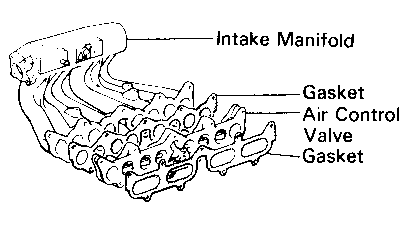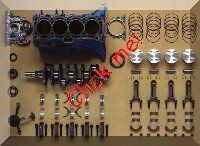
Welcome, from sunny Australia!
The Stock 4AGE Description Page - Manifolds, etc

The Stock 4AGE Description Page - Manifolds, etc
4AGE manifolds
INLET MANIFOLD - 16 Valve
The big port heads, apart from the
supercharged 4AGZE's, all use the TVIS (Toyota Variable Induction
System) to improve the low to mid range torque. What it does is shut
down half of each inlet port with a set of small butterflys to make the
airflow go into the inlet port itself a lot faster. Certainly, with a
stock engine the low end performance is noticably decreased when it's
disconnected.

The TVIS is operated by a small vacuum
powered device that sits under the inlet manfold, and the vacuum source
for this is provided by a computer controlled air solenoid, that get's
the vacuum source from the inlet manifold. When the engine isn't
running, the TVIS isn't working, and so the butterflys are in the open
position. When the engine starts, the computer sends a signal to the
electrical solenoid, with then passes on the inlet vacuum to the TVIS
vacuum solenoid, which then shuts the butterflys. So, if you want to try
the engine to see what it's like without the TVIS, all you have to do is
to pop the vacuum hose off (and block it) and the TVIS will stay open.
The computer signals for the TVIS to operate
at 4,400rpm - above that rpm the butterflys are open, and vice-versa. At
that rpm, the amount of power that the engine makes is the same with the
TVIS open or closed, so you don't feel any increase in power when the
system operates, though there is an increase in induction noise.
(Note that even with the TVIS completely
removed, as with my current 4AGE, the 4AGE still changes note quite a
lot at around those rpm's)
The small port inlet manifold has no TVIS, and so is a conventional plenum/runner type manifold, though it only comes in FWD configuration.
The RWD inlet manifolds all have the
throttle body system at the front end of the engine, with the FWD's at
the other end. There is basically no other differences with them.
For what it's worth, a reasonably common mod
is to fit a small port engine to an AE-86, and to do this the FWD
manifold is modified so that the throttle body is at the 'other' (front)
end. This takes a fair bit of cutting & welding, but seems to be
worth the cost and effort
The inlet throttle butterfly is 55mm in diameter, and will flow more air than any amount of power that you can get out of the 4AGE with the factory inlet manifold, so there is no need whatsoever to fit a larger one, as some people do. I have seen a report on a dyno run that shows an engine with a 60mm throttle body fitted - ~20% more throttle area - making about 1 - 2hp more, which is more likely to be dyno error than anything else.
At the bottom of the throttle body is a
wax pellet type of 'cold idle up', and it has engine water running
through it so that when the water is cold the device lets an additional
amount of air pass into the inlet manifold to keep the idle speed
normal. As the water and wax warms up, the device passes less and less
air, until the engine is fully warm. They tend to be a bit unreliable
when they get old, and often need replacement.
The other occasional problem with the 16v throttle bodies is that
people do not allow a little bit of slack in the throttle cable with
the accelerator full-down, and this puts a strain on the cable and
throttle body - I've seen a few break because of it so please mack sure
that you're not loading up the throttle body like that.
INLET MANIFOLD - 20 Valve
Very good indeed - They have a single
throttle butterfly for each cylinder, and so are about as good as a very
good racing inlet system.
Hot property, they are!
One slight problem though, if you want to
fit one to your 16v - They won't bolt on and so require an adaptor, and
more importantly they have ZERO inlet manifold vacuum, so the computer
won't work ... An aftermarket add-on using TPS (Throttle Position Sensing Vs rpm) only for the 16v's.
(That being said, I've read a few reports
from various people that say that they've gotten the stock 16v computer
& 20v inlet manifold to work together okay)
EXHAUST
The factory exhaust manifold is very good
with all types, both FWD & RWD, and up to about 200hp they are
better than just about every aftermarket exhaust manifold available.
They are a 4-2-1 design, and all types fit all the engines, with the
exception of the 20v manifold, which has the two bolt holes on the
extreme ends in a slightly different place to the 16v ones. But - by
slotting the holes on the 16v manifolds, they can be made to fit quite
easily on a 20v; usually this is done to convert a 20v to a RWD car.
You'd be far better off getting things such as lightweight flywheels,
etc, to improve performance, as the engine will definitely benefit from
these, rather than one of dubious increase at best ...
4AGE Blocks
There are basically two types of 4AGE
blocks; The ones that are just single cam blocks used for twin cam work
and have three ribs on the side, and the small port, 4AGZE, and 20v
blocks which have seven ribs. The three rib blocks can only been
overbored a small amount, roughly 1mm or 0.040", (82mm total) and the
seven rib blocks can sometimes (but not always) go a bit further to 2mm or 0.080". (83mm total) An
important note though is that the bigger the bore and/or the more power
the engine is making, the more blow-by you'll be getting. I doubt if
it's worth boring the block out to try to get more capacity for that
reason.
The 20v blocks have a slight bend in one side, along the section where the sump bolts on., so that a 16v sump won't bolt
straight on. But with some small mods they can be made to fit, I've
heard.
The seven rib blocks on the small port
4AGE's also have an oil return pipe on the right-rear from the back of
the head. The 4AGZE's & 20v's have the 'bump' in the block for that
hole, but it's solid cast metal there instead.
Another good feature of the seven rib blocks
is that they have an oil-squirter system that pumps oil onto the bottom
of the pistons, thus helping cool them.
There's no other significant differences between all the
blocks.

4AGE Cranks, con-rods,
and pistons
There's two types of crankshafts available;
They both have the same size main bearings, but the 'lightweight' or
'small' one has 40mm con-rod bearing sizes, with the other 'big' one
having 42mm bearings. The 'small' crank only comes with the TVIS
engines, and vice-versa - The 4AGZE and the 20v engines all have the
42mm crank.
Both cranks are extremely strong, and only
break with quite a bit of mis-treatment. The 40mm crank weighs
about 11kg and the 42mm crank about 11.7kg.
As there is two types of crankshaft,
there are also two types of con-rods; One 'big', one 'small'. (42mm and
40mm) Note that the 'big' con-rods are quite a bit heavier than
the 'small' con-rods, and also have 20mm gudgeon pins Vs the 'small'
con-rods 18mm gudgeon pins. Again, both types are very strong and give
no trouble at all.
There are bascially three types of
pistons - One for the 16v naturally aspirated, 20v, and supercharged
4AGZE. The 16v ones come with 18mm and 20mm gudgeon pins, (18mm = TVIS
only) the 20v are 20mm and have three flycuts for the three inlet
valves, (all 4AGE pistons have flycuts for each valve though) and the
4AGZE shares the 20mm gudgeon pin diameter. The 4AGZE pistons have a
lower deck height to give a lower compression, and are also ceramic
coated on the tops to improve heat rejection.
All these pistons give no trouble in regular
service, though they are of the slotted type with the oil return ring
groove, thus are weaker than the 'drilled' type. They are also cast
rather than forged, (though the 4AGZE's are forged) and so if you are
planning on increasing the power of your 4AGE by more than, say, 30hp
then you would do well to get a set of aftermarket, eg, Wisco, pistons
to make sure that you don't have any trouble.
FWIW, I have run my dead stock 4AGE up to
8500rpm without any troubles from the internals.
And on another page -
- 4AGE Oil System,
4AGE Water System, 4AGE EFI, 4AGE Other Stuff
Back to the Index page
Page & contents where applicable © Bill Sherwood